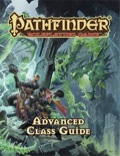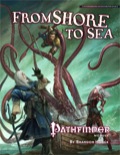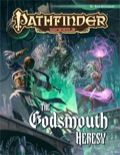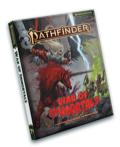Sign in to create or edit a product review. 
Pathfinder Roleplaying Game: Advanced Class Guide (OGL)Paizo Inc.Hardcover Unavailable Add PDF $19.99 Non-Mint Unavailable Sloppy but accomplishes its goalsPathfinder tries to reinforce the idea that the game should give you the tools to fully realize your character concepts. Pathfinder establishes classes as more of a starting point, rather than a straight-jacket, to build the character you want to play. In the past, it did accomplished this through archetypes, traits, and class features that work like rogue talents. The Advanced Class Guide now truly blurs the line between classes by introducing 10 new "hybrid" classes that combine the theme of two existing classes to create unique features in their own right. The arcanist is a 9-level spellcaster that does not need to prepare multiples of the same spell to cast it and gains a talent pool to do a variety of neat things. The bloodrager is a 4-level spellcasting full BAB martial that gain the benefits of a sorcerer-like bloodline while raging. The brawler is a full BAB fighter/monk that can temporarily gain the benefit of a combat feat to adapt to any situation. The hunter is a 6-level gish class that uses druid and ranger spells, and gains an animal companion that benefits from teamwork feats. The investigator is a delightful skill monkey class that can use alchemist extracts, buff their skill checks and attacks with a resource pool, and make a special attack against a target they studied. The shaman communes with a spirit and gains special abilities from it, which makes me think of the pactbinders from Pact Magic Unbound. The skald is a barbarian that performs as he rages, giving benefits to his allies. The slayer is an assassin class meant to act as a "patch" for the rogue, except it focuses mostly on combat and singling out a single target. The swashbuckler, my most anticipated class, is an agile fighter that can perform stunts using a resource pool like a gunslinger's grit. The warpriest is a 6-level divine gish class that have the ability to cast spells on themselves as a swift action and a weapon whose damage dice scales like a monk's unarmed strikes. The book also introduces a some ambitious archetypes and feats that I applaud. These include a Charisma magus archetype, multiple multiclass archetypes, a gunslinger archetype that specializes in crossbows instead of firearms, feats that trigger off of Arcane Strike, multiple alternates to Stunning Fist that do other conditions, and a whole line of feats that add bonus effects to Vital Strike. I am, however, very sad there's few options for the magus, my favorite class. The bard and the barbarian got two hybrid classes. I would have loved to see a monk/magus, but alas. However, the book really drops the ball with the archetypes and feats section. While I praise the ambition shown in some of these entries, most of them are really sloppy. Typos are all over the place. Some archetypes refer to abilities that don't exist. Some break existing class features and don't replace them. The worst issue is that the class designers obviously wrote the class descriptions with the assumption certain feats would exist to support the class. The swashbuckler is the worst offender as the heavily advertised "Dexterity to damage" feature came as a poorly designed last minute addition tacked onto an existing feat. That class really got the short end of the stick, and I hope Paizo will aggressively remedy the problem. The Class Design Guide at the end of the book left me wanting more. While I wasn't expecting something as thorough as the Race Builder in Advanced Race Guide, I wished this section flowed more like the spell creation guide in Ultimate Magic or perhaps a "behind the scenes" look at how the designers create classes and archetypes. Ultimate Magic's spell guide gave a lot of insight in how spells are designed, provided a list of benchmarks for each spell level, gave examples of both good and bad spells, explained damage metrics for arcane and divine spellcasting. By contrast, Advanced Class Guide merely shows the differences between classes of different BAB and that abilities are either "secondary" or "primary." I cannot even call it a "dev blog" as I've read way better blog articles on class design than this. Why four stars with all these problems? While Paizo obviously rushed additional options to get the book out the door to GenCon, much care was taken into the creation of the 10 new classes. 9 out of the 10 classes look rather well done. This book brought us a new standard for full BAB classes, all of which look fun to play. It gave us the slayer, a "patch" for the rogue until Pathfinder Unchained. Despite each class being a hybrid, nearly all of them have unique game mechanics never seen in a Paizo product. Even if you turn your nose up at adding more bloat to the game, I still recommend the book if only to cannibalize the new classes to patch/houserule the classes in the Core Rulebook. While sloppy and unpolished, Advanced Class Guide accomplished its goals: give us new classes that raise the bar in terms of gameplay and design. I had started a sea voyage campaign when I got the PDF for this, hoping to use its material. Unfortunately, I ended up regretting this. The PDF is so poorly optimized that loading it on my gamer desktop computer lags like crazy. It flat out crashes any PDF reader I use on my tablet. I wish I could say the material is worth the hardcover price, but this is not so. I find the book very difficult to follow and study as a GM. I still haven't figured out what the overall plot of some of the adventure paths are. The setting leaves much to be desired. The only value I got out of Razor Coast was a two room dungeon that my players ended up bypassing anyway. This felt like $40 down the drain. 
Pathfinder Module: From Shore to Sea (PFRPG)Paizo Inc.Add PDF $19.99 Print Edition Unavailable Non-Mint Unavailable Good on paper, disastrous in practiceWhen I read this module, it looked really awesome, and I couldn't wait to run it. When I actually did run it, my players had the worst experience ever at my table. In fact, this marked one of the few times my players were actually very angry at me. While the encounters, plot, background, and maps are high quality, several issues make the adventure frustrating to play. 1) Because of the structure and order of locations and events, the adventure gives very little exposition until very late in the module. My players were left with almost no information to act on. Every decision they made felt like a shot in the dark. 2) The island's effects misled the players into believing there's a time limit. This put a lot of stress on my players, disabling them from leisurely exploring the island at their own pace. Worse is that it railroaded my players into continuing an adventure they had no fun with. It was so bad that a couple of the PCs preferred they leave and spend another adventure curing themselves than actually finishing out the adventure. 3) Martial characters felt completely useless. Nearly all of the adventure's major challenges require magical expertise. All non-spellcasters in my group spent most of the two 4-hour sessions twiddling their thumbs while the spellcasters solved the mystery. 4) I also noticed that sometimes the text did not match the maps provided. For example, the description said one location was in the west when it was north on the map. Thankfully, all of these can be avoided with some clever GMing. If you wish to run this adventure, I suggest the following recommendation:
Spoiler:
Have the party encounter Sara or the villagers early when they visit the island. My players struggled because they lacked a clear objective other than wander around the island hoping they find something. The module does not let the Sara encounter line doesn't happen until they find the excavation site, which is likely the very last place they'll visit. Overall, From Shore to Sea has a great story and premise marred by poor sequencing and a frustrating pseudo-time limit mechanic. 
Pathfinder Module: The Godsmouth Heresy (PFRPG)Paizo Inc.Add PDF $19.99 Print Edition Unavailable Non-Mint Unavailable Lame Story, Cool MapI personally thought the story was rather lame. I don't know, the villain just did nothing for me, even though I did like how they were playing with Pharasma lore with his backstory. The map also has a difficult swarm monster, which even a 2nd level party would have no answer. While running away is a viable option, it feels odd that a swarm of cockroaches is the most dangerous creature in a dungeon full of demons and undead. The real gem of the module is the map. It's a pretty fantastic map with lots of colorful background flavor surrounding Thassilon lore. This makes the map an excellent adventure for any Varisian campaign or any campaign that plays with Thassilon and the runelords. My players were completely oblivious to Pathfinder lore, but after this module, they wouldn't stop talking about the runelords. The map, though, does have a few problems of its own. There are several areas my players absolutely refused to explore simply because they smelled like a trap but gave no incentive to look into it. The best example is one pair of rooms that do a neat, terrifying, and yet relatively harmless effect to any that linger in it. However, no sane player would ever go into the room. There's no incentive to enter it and it just screams "THIS IS A TRAP." There's also several staircases that lead to other areas not featured in the module. It's great if you have the supplements or another dungeon in mind. For me, this module took three or four sessions to finish. Neither I nor my players wanted to use up more time there. It was extra work to make sure every "hole" was plugged in. Even having a collapsed stairway was enough to make my players waste resources getting to an area that wasn't there. It's rather annoying and comes off as a shameless plug for other materials. Over all, Godsmouth Heresy is decent. It has a good map that touches on Thassilon lore that makes the whole module worth getting. And while I did not like the story, your players may think differently. I personally like fumbles because they can add tension and drama to a fight when done right, but can turn an epic fight into slapstick comedy if down wrong. I bought this to have a tool for more creative fumbles, because I'm tired of the usual 'drop prone' or 'your weapon flies out of your hand.' Unfortunately, that's precisely the type of fumble effects you see in this deck. Most of them are damage or ability score damage. Some are silly (create a stink cloud around you).
Several, particularly the mage fumbles, are easily character-ending. Such as teleporting next to an enemy or immediately taking heavy damage. Some GMs might still find this useful. However, I highly advise you exercise creativity and judgment when integrating this with your game. Overall, I looked for a convenient tool for coming up with creative ways to add suspense and drama to a fight. Instead, I got a deck of ways to clown my players to death. I was excited to get this deck, but now I'm not sure if I really want to use it. 
Pathfinder Module: Master of the Fallen Fortress (PFRPG)Paizo Inc.Print Edition Out of print Add PDF FREE Great Map! Stupid Encounters. Lame StoryI used Fallen Fortress for my very first module and heavily modified it with a new story, replacing some nonsense encounters, populating boring areas, and made it into a sandbox dungeon crawl trying to rescue a damsel in distress. It turned out great and the players had a blast. What made it wonderful is that the map is absolutely fantastic. It's an intriguing shape with plenty of ways for you to set up alternate routes and surprises. It's small enough to make the adventure short, but large enough to keep players wanting to explore. It's also easy to add floors, if you wish to make it bigger. The downfall is that the story is lackluster and many of the encounters don't make any sense, like a giant frog that's isolated in a room and one large room that has absolutely nothing in it except for a javelin trap. If you must make any change, I recommend swapping the fire skeletons for normal ones. Those things can easily kill a 1st level PC in one round, never mind the damage reduction. The Pathfinder RPG Ongoing Subscription is basically a way for you to pre-order upcoming Pathfinder products. Once you sign up, you will automatically receive new products as they're released, being billed automatically for each one. As a bonus, you get free PDFs of rulebooks you buy from the subscription. I started (and ended) my subscription with the Advanced Race Guide. I was very happy with the book, speed of delivery, and the free PDF. However, I have mixed feelings about the Ongoing Subscription service. THE GOOD:
2. You can cancel anytime. You can get one product and then immediately cancel with no penalties, essentially using the service as a way to pre-order products. 3. You save a few bucks. The free PDF saves you a few bucks. Not too much with the shipping, but it's still a discount. THE BAD:
2. Canceling is a hassle. You have to manually contact customer service to cancel your subscription. Not cool, especially when there's a risk of being forced to pay for something you don't want. 3. Shipping and handling is expensive. It's twice the price of Amazon (plus they have offers for free shipping). Even with the free PDF, you're only saving a few bucks. Overall, if you don't mind the cancelling hassles, I'd recommend it if something you want is up next. However, the lame trinkets and the cancellation inconveniences really hinder Ongoing Subscription from being a stellar service. Otherwise, this would be something all regular Pathfinder players should have.
|
|





